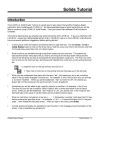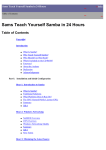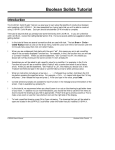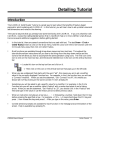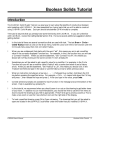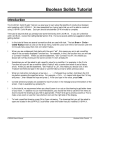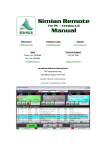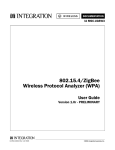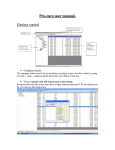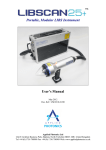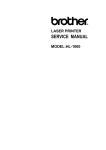Download Pipe Cavity Tutorial Introduction
Transcript
Pipe Cavity Tutorial Introduction The CADMAX Solid Master Tutorial is a great way to learn about the benefits of feature-based parametric solid modeling with CADMAX. We have assembled several typical parts that you will be able to construct using CADMAX Solid Master. Each part should take between 20-40 minutes to complete. The tutorial assumes that you already have some familiarity with CADMAX. If you are unfamiliar with CADMAX, review the Getting Started section first in CADMAX Help or in the CADMAX Users Manual. Here are several additional suggestions before getting started: ! In the tutorial, there are several conventions that are used with text. The text Draw > Circle > Center Radius means to click on the Draw menu, hold the cursor over the Circle function until the Circle submenu pops, then click on Center Radius. ! Most functions are available through drop-down menus and icon tool bars. Throughout the tutorials the written instructions tell you how to do things from the drop-down menus and the icons to the left show you how to accomplish the same operation using icons. The first icon is the icon to click on the main tool bar, and the second indented icon is the icon on the vertical function bar. < Locate this icon on the top tool bar and click on it. < Then click on this icon on the vertical tool bar that pops up on the left side. ! When you see a statement that starts with the word “set”, this means you are to set a modifier value in the currently displayed Function box. For example, in the Line function box, you will see a -Connect? modifier. When you see the statement, “Set -Connect? to off”, this means you should set it off by clicking on the word Connect if it isn’t already off. ! Sometimes you will be asked to set a specific value for a modifier. For example, in the Circle Function box you will see a modifier called -Radius? with a combo box below it and a history arrow. When you see the statement, “Set -Radius? to .25”, you should click in the -Radius? text field and type in the value or use the history arrow to select previous value. ! When an instruction includes an arrow key (6 7 8 9) followed by a number, hold down the Ctrl key before pressing the specified arrow. For example, <Ctrl+6>1 means hold down the Ctrl key and press 6, then release the keys and press 1. After you type in the value, press Enter. ! Context sensitive prompts are available for each function in the message area at the bottom of the screen. Help is available buy pressing F1. CADMAX User's Manual Solids Tutorial / 1 ! In the tutorial, we recommend when you should zoom in or out on the drawing to get better views of your work. In addition to our recommendations, you should feel free to use the View menu or the Quick View toolbar to zoom around the drawing as you feel is appropriate. Press F10 to go to previous zooms or F11 to make a new zoom. ! To load a specified drawing, press F4 to Open a drawing. The drawings that you will be asked to open are located in the \SAMPLES sub-folder under the folder that you installed CADMAX. 2 / Solids Tutorial CADMAX User's Manual Pipe Cavity The second solid drawing you will model is a pipe cavity as shown in the figure below. CADMAX User's Manual Solids Tutorial / 3 Opening a Sketch 1. Open the drawing FEATURE.CXS from the /SAMPLES folder which is a subfolder under the folder you installed CADMAX. 2. Click on Edit > Feature Modeling or click on the Feature Modeling icon on the Ribbon bar. The first feature of the part is going to be an extruded cylinder. You will start by sketching a profile of the cylinder on a work plane and extrude it to give it thickness. 3. Click on Edit > Sketch or click on the Sketch icon on the ribbon bar. This starts a new sketch and displays the Work Plane function box. The Work Plane function box shows different methods to locate the sketch plane, depth, rotation and twist. Once the work plane is defined, the Sketch function bar will open and place you in the Sketch Line function. The Sketch function bar contains many of the functions you will use to draw and dimension a sketch. 4. Set the -Method? to ‘View’ and click on the front view (lower left). Now, no matter which view you work in, as you sketch your object, the geometry will always be oriented to the front view. 5. Click on Draw > Sketch Circle. Working in the front view, draft a circle by clicking on the center point, drag the cursor away from the center and click to place the circle. 4 / Solids Tutorial CADMAX User's Manual Adding Dimensions Dimensions are used to make the geometry the desired size. CADMAX does not require that you add dimensions before you extrude the model. You can always return to the sketch and add dimensions or change the sketch later in the design. 1. Click on Dimension > Radial. 2. Click on the circle. Drag the cursor to the desired text position and click to place the dimension. 3. Type in 5 and press Enter. This assigns a value of 5 for the dimension and automatically resizes the circle according to the assigned value. You can always change this value at a later time using the Equation function. Extrude the Circle The first feature in a part is called the base. 1. Click on Feature > Extrude Sketch or click on the Extrude Sketch icon on the top tool bar. The Extrude Base dialog box appears so you can specify the type and distance of the extrusion. 2. Set -Extrude Distance? to ‘15' and -Extrude Extent? to ‘Distance Above’. CADMAX User's Manual Solids Tutorial / 5 The extrusion takes place toward the point that you click. The direction of the extrusion is defined by the side of the sketch that you click on. Working in the top view (top left), if you click above the circle, then the extrusion will take place in that direction. Clicking below the circle brings the extrusion toward you. 3. In the top view, click anywhere below the circle. Notice that: • • • The new feature, Base1, appears in the Feature tree. The top level function bar has changed for Modeling. The sketch was extruded in each view. Set the Display Preferences You change the orientation of a view or how a view is displayed in order to see boundaries that are not visible in a view. The 3D Quick View tool bar on the right side of the screen contains functions to change a view to wireframe, hidden, hidden-dashed, shaded or unshaded. Following are the icons that permit you to change how a view is displayed. To operate these functions, click on the icon, then click on the view to change. Wireframe View Shaded View Hidden View Unshaded View Hidden dashed View To rotate a view, use dynamics. Click on the Dynamic View Roll icon, then click on the view to roll, then click on a roll about point to start the roll. Normally, the roll about point is on geometry in the model. Drag the cursor in the direction of the roll and click again to anchor the view at the new orientation. Use Previous View in the 3D Quick View tool bar to return the view to its original orientation. Dynamic View Roll 6 / Solids Tutorial Previous View CADMAX User's Manual 1. Click on Hidden in the 3D Quick View tool bar, then click on the isometric view to make it hidden. 2. Click on Hidden-dashed in the 3D Quick View tool bar, then click on the front, top, and side views to make each view hiddendashed. 3. Use Dynamic View Move to move the geometry up in the top view. If some of the geometry is outside the view window, you can easily pan the window. Click on Dynamic View Move in the 3D Quick View tool bar. Click on the view to move. Then, click on the point to move the view about. Click again to place the view at the new location. The graphic to the right shows the geometry in the top view moved up. Add Front Opening 1. Click on the Edit > Sketch or click on the Sketch icon on the ribbon bar to start a new sketch. 2. Set the -Method? to ‘Face’, -Adjustment? to ‘None’, and in either the front or isometric view, click on the front face of the base cylinder as indicated in the figure. Click on this face As you wave the cursor over the object, the face that will be selected displays in red. Make sure the front face is red before you click on it. 3. Zoom in on the front view. CADMAX User's Manual Solids Tutorial / 7 The smaller opening is going to be centered on the front face. It will have a radius of 3. 4. Click on Draw> Sketch Circle. Wave the cursor over the edge of the circle until the center point of the circle pops up in the display, then click on the center point and drag the cursor away from the center point and click to place a circle smaller than the original circle. The circle has been constrained to be concentric with the original circle. A dimension needs to be added for the radius. 5. Click on Dimension > Radial. 6. Wave the cursor over the smaller circle until it turns red and an echo of the radial dimension is displayed. Click on the circle, drag the cursor to locate the text, and click to place the radial dimension. Type in 3 and press Enter to set the radius of the circle to 3. 7. Press F10 or click on Previous in the Quick View tool bar to display the four views. 8. Click on Feature > Extrude Sketch to display the Extrude function box. Select Boss as the type of extrude. 9. In the Extrude Boss function box, set: • • • 8 / Solids Tutorial -Target Solids? to ‘All’ -Extrude Distance? to ‘3’ -Extrude Extent? to ‘Distance Above’ CADMAX User's Manual 10. Click anywhere below the object in the top view to show the direction of the boss. Notice that: • • • The new feature, Boss1, appears in the Feature tree. The top level function bar has changed for Modeling. The front cylinder has been added to the base. Shell Cylinder The Shell feature is used to remove specified faces of an object and to set a wall thickness. 1. Click on Select > Select Element. 2. In the isometric view, click on the surface identified by the “P” in the figure shown at right. Make sure you click on the surface and not the edge. If necessary, zoom in to select the surface. P As you click the surface, its boundary geometry will turn yellow and a surface tag will be displayed. In this case, since the selected surfaces were planes, the surface tag is a “P”. 3. Click Feature > Shell. 4. Set -Thickness? to ‘1' and click Finish. CADMAX User's Manual Solids Tutorial / 9 Create Top Opening The top opening is going to be created using a 360 degree Swing feature. The center of opening is 4.5" from the rear of the main cylinder. The work plane for the profile of the opening needs to be offset 4.5" from the rear of the main cylinder. 1. Click on the Edit > Sketch or click on the Sketch icon on the ribbon bar to start a new sketch. 2. In the Work Plane function box, set the -Method? to ‘Front’, -Adjustment? to ‘None’ and the -Offset? to ‘4.5'. In either the top or isometric view, click on the rear edge of the base cylinder as indicated in the figure. The work plane will be oriented to the front view and offset 4.5 from the rear of the main cylinder. 3. Zoom in on the front view. 4. Click on Draw > Sketch Line. Working in the front view, draw a profile similar to the one shown in the figure. Start the profile at the center point of the circle. Wave the cursor over the center point of the circles to display the horizontal and vertical dynamic construction lines. As you work, use the dynamic construction lines as guides to help you make vertical and horizontal lines. For the last point, you may have to wave the cursor over the center point again to get the construction line in order to make the proper snap. As you draw the profile, make sure none of the points snap to circle edges, otherwise, the point will be constrained to the edge. 10 / Solids Tutorial CADMAX User's Manual 5. When you are creating a Swing feature, a line must be added to the sketch defining the axis that the profile will swing about. The swing axis is going to be a vertical line through the center of the cylinder. Click on Draw > Sketch Line, then click on Centerline in the Line function box. Continuing to work in the front view, click on the center point of the circles and click on any point on the vertical dynamic construction line to make a vertical centerline. Adding Dimensions Use dimensions to size the geometry. CADMAX does not require that you add dimensions before you extrude the model. You can always return to the sketch and add dimensions or change the sketch later in the design. Add the dimensions shown in the figure to the right. 1. Click on Dimension > Horizontal. Double-click on the top edge of the profile. Drag the cursor to the desired text position and click to place the dimension. CADMAX automatically snaps to the end points of the line when you doubleclick unless the midpoint is under the cursor. Then, CADMAX snaps to the midpoint. Alternatively, click once on each of the endpoints of the top edge. Drag the cursor to the desired text position and click to place the dimension. CADMAX User's Manual Solids Tutorial / 11 2. Type in 6.25 and press Enter. This assigns a value of 6.25 for the dimension and automatically resizes the profile according to the assigned value. 3. Double-click on the bottom edge of the profile. Drag the cursor to the desired text position and click to place the dimension. Type in 3.75 and press Enter. This assigns a value of 3.75 for the dimension and automatically resizes the profile according to the assigned value. 4. Click on Dimension > Vertical. Doubleclick on the upper left edge of the profile. Drag the cursor to the desired text position and click to place the dimension. Type in 1.37 and press Enter. This assigns a value of 1.37 for the dimension and automatically resizes the profile according to the assigned value. 5. Click on the end-points of the right edge of the profile (Note: Since the Centerline is there you cannot double-click because it may result in the wrong points). Drag the cursor to the desired text position and click to place the dimension. Type in 9.15 and press Enter. This assigns a value of 9.15 for the dimension and automatically resizes the profile according to the assigned value. 12 / Solids Tutorial CADMAX User's Manual Swing Profile 1. Click on Feature > Swing Sketch or click on the Swing Sketch icon on the main tool bar. 2. Set -Boolean Choices? to ‘Boss’. 3. In the Swing Boss function box, set -Target Solids? to ‘All’ and -Rotation Angle? to ‘360'. Click anywhere in a view to apply the Swing feature. Insert Hole in Top Opening The top opening is going to have a 1.75 hole into the main cylinder. In order to assure that the hole is always through the entire top opening, its extrude distance needs to be equal to the height dimension in the previous profile, which was 9.15. 1. Determine the name assigned to the 9.15 dimension. Click on the Variables icon on the ribbon bar to display the variables table. CADMAX User's Manual Solids Tutorial / 13 In the feature tree, right-click on Boss2 and click on Show in the pop-up menu or wave the cursor over the Swing Boss feature in the drawing, right-click and click on Show in the pop-up menu. This action displays the dimensions in the drawing and the variables for the Swing feature in the Variables table as shown below. From the table the 9.15 dimension is named ‘d4'. Depending on the sequence that you added these dimensions, your dimension name may be different. 2. Click on Edit > Sketch or click on the Sketch icon on the ribbon bar to start a new sketch. 3. In the Work Plane function box, set -Method? to ‘Face’ and -Adjustment? to ‘None’. In the isometric view, click on top face of the top opening to set this surface as the work plane. 4. You can work in either the top or isometric view. Zoom in on one of the two views. If you are going to work in the top view, you may want to change it from ‘hiddendashed’ to ‘hidden’. 14 / Solids Tutorial Work Plane CADMAX User's Manual 5. Click on Draw > Sketch Circle. Wave the cursor over the edge of the circle until the center point of the circle pops up in the display, then click on the center point and drag the cursor away from the center point and click to place a new circle which is smaller then the original circle. The circle has been constrained to be concentric with the original circle. A dimension needs to be added for the radius. 6. Click on Dimension > Radial. Wave the cursor over the circle until it turns red and an echo of the radial dimension is displayed. Click on the circle, drag the cursor to locate the text and click to place the radial dimension. Type in 1.75 and press Enter to set the radius of the circle to 1.75. 7. Press F10 or click on Previous in the Quick View toolbar to display the four views. 8. Click on Feature > Extrude Sketch to display the Extrude function box. Select Cut as the type of extrude. CADMAX User's Manual Solids Tutorial / 15 9. Set -Target Solids? to ‘All’, set -Extrude Distance? to ‘5’ and set -Extrude Extent? to ‘Distance Above’. 10. In the front view, click anywhere below the face of the work plane to apply the extrude and create the Cut1 feature. 11. On the feature tree or the drawing, rightclick on the Cut1 feature and click on Show in the pop-up menu to display the variables for Cut1 in the Variables table. As an alternative, you can double-click Cut1 to display its variables. 12. Click in the Equation field for Extru3. Instead of using the value that was assigned when the feature was created, we always want the value to be equal to ‘d4' which is currently 9.15. Type in ‘d4' in the equation field and press Enter. The value for Extru3 updates to 9.15. 13. Click on Feature > Rebuild. The model rebuilds with the hole through the Boss2 feature. Even if the dimension changes, the hole will always go through the feature. 16 / Solids Tutorial CADMAX User's Manual Add Fillets 1. Click on Select > Select Element and click on the edges shown in the figure. Notice that the edges and surfaces highlight in red as you move the cursor over them identifying which item will be selected. Make sure only the edges are highlighted when you click on them. 2. Click on Feature > Fillet, Fixed. The Fillet function box appears. 3. Set -Fillet Radius? to ‘.25' and click Finish to apply the fillet feature to the selected edges. 4. Click on Select > Select Element and click on the edge shown in the figure. 5. Click on Feature > Fillet, Fixed. The Fillet function box appears. Set -Fillet Radius? to ‘.625' and click Finish to apply the fillet feature to the selected edge. 6. In the Quick 3D View tool bar on the right edge of the display, use Dynamic Roll View to view the model from the rear. Notice that the model blends where the two fillets meet. Then, use Previous View to change the view back to its original orientation. CADMAX User's Manual Select edge Fillet blends Solids Tutorial / 17 Insert Outlet Opening In the following steps, insert a .5 inside radius opening at a 45 degree angle when looking at the model from the front view. A work plane needs to be constructed at a 45 degree angle starting from the center of the main cylinder. The work plane is based off the side view, rotated negative 45 degrees. 1. Click on the Edit > Sketch or click on the Sketch icon to start a new sketch. 2. In the Work Plane function box, set the -Method? to ‘View’, -Adjustment? to ‘Origin’, and set the -Rotation Angle? to ‘45'. Click on the side view to determine the plane to rotate from. Notice in the other views how the plane is already rotated. Click on the Center Point snap icon in the Quick Snap tool bar on the right edge, position the cursor over one of the circles of the cylinder in the front view. Notice that the plane snaps to the center, click to place the plane. 3. Zoom in on the side view. 4. Click on Draw > Sketch Circle in the Sketch function bar. Wave the cursor over the edge of one of the circles of the cylinder until the midpoint of the circle pops up in the display and its horizontal construction line. Click on a point along the horizontal construction line and drag the cursor away from the center point and click to place the circle. 5. Use dynamic construction lines from midpoint of arc to position the circle Click on Dimension > Radial. Wave the cursor over the circle until it turns red and an echo of the radial dimension is displayed. Click on the circle, drag the cursor to locate the text and click to place the radial dimension. Type in .75 and press Enter to set the radius of the circle to .75. 18 / Solids Tutorial CADMAX User's Manual 6. Click on Dimension > Horizontal. Click on the center point of the circle and click on the edge of the main cylinder as shown in the figure. Drag the cursor to the desired text position and click to place the dimension. Type in 2.25 and press Enter. This assigns a value of 2.25 for the dimension and automatically positions the circle. 7. Press F10 or click on Previous in the Quick View tool bar to display the four views. 8. Click on Feature > Extrude Sketch to display the Extrude function box. Select Boss as the type of extrude. 9. In the Extrude Boss function box, set: • • • CADMAX User's Manual -Target Solids? to ‘All’ -Extrude Distance? to ‘10.3’ -Extrude Extent? to ‘Distance Above’ Solids Tutorial / 19 10. Click anywhere above the object in the front view to show the direction of the boss and to apply the feature. Create Outlet Opening Hole To insert a .5 radius hole through the outlet, you will reuse the previous work plane and extrude a .5 circle through the object. The extrusion distance will be assigned the name of the 13.3 extrusion just inserted. 1. Click on the Edit Sketch or click on the Sketch icon on the ribbon bar to start a new sketch. 2. Set the -Method? to ‘Sketch Plane’. Position the cursor over the geometry of the outlet feature just inserted until the work plane for the feature echos, then click to reuse that work plane for the new feature. 3. Click on the Hidden-dashed icon on the Quick 3D View tool bar and click on the side view to make the view hidden-dashed, if it isn’t already. Zoom in close on the side view as indicated in the figure. 20 / Solids Tutorial CADMAX User's Manual 4. Click on Draw > Sketch Circle. Using the center point of the circle shown, click on the center point and drag the cursor away from the center point and click to place the circle, making sure that your radius of the new circle is not the same size as the circle whose center point you are using. Otherwise, the circle you are inserting will be constrained to equal radius. 5. Click on Dimension > Radial. Wave the cursor over the circle until it turns red and an echo of the radial dimension is displayed. Click on the circle, drag the cursor to locate the text and click to place the radial dimension. Type in .5 and press Enter to set the radius of the circle to .5. It isn’t necessary to assign any additional constraints to the circle, because it has a concentric constraint to the first circle. 6. Click on Feature > Extrude Sketch to display the Extrude function box. Select Cut as the type of extrude. 7. In the Extrude Cut function box, set: • • • CADMAX User's Manual -Target Solids? to ‘All’ -Extrude Distance? to ‘10.3’ -Extrude Extent? to ‘Distance Above’ Solids Tutorial / 21 8. Click anywhere above the object in the side or front view to show the direction of the cut to apply the feature. 9. Double click on the Boss feature just inserted to display its variables. It should be called Boss2 and note the name of the extrusion variable. In the table below, it is Extru4. 10. Double click on the Cut feature just inserted to display its variables. It should be called Cut2. In the Equation field for Extru5, enter Extru4 so that the two values will always be identical. 11. Click on Feature > Rebuild. 22 / Solids Tutorial CADMAX User's Manual Remove Excess Geometry The inside of the main cylinder contains excess geometry that must be removed. Use an Extrude Cut feature to remove the geometry. 1. Click on the Sketch icon on the ribbon bar. 2. Set the -Method? to ‘Front’, -Adjustment? to ‘None’ and click on the inside edge of the main cylinder as shown. By setting the -Method? to ‘Front’, you can orient the plane to the front view and set the depth with a single click. 3. Press F10 or click on Previous in the Quick View tool bar to display the four views and then zoom in on the front view. Click on the Hidden-dashed icon on the Quick 3D View tool bar and click on the front view to make the view hidden-dashed, if it isn’t already. 4. Click on Draw > Sketch Circle. Click on the center point of one of the shown circles, drag the cursor away from the center point until it is the same radius as the circle shown and click to place the circle. This constrains the circle to have an equal radius to the inside of the main cylinder. 5. Press F10 or click on Previous in the Quick View tool bar to display the four views. 6. Click on Feature > Extrude Sketch to display the Extrude function box. Select Cut as the type of extrude. 7. In the Extrude Cut function box, set: • • • CADMAX User's Manual -Target Solids? to ‘All’ -Extrude Distance? to ‘13’ -Extrude Extent? to ‘Distance Above’ Solids Tutorial / 23 8. Click anywhere to the rear of the model in the front view to show the direction of the cut and to apply the feature. Create a Bolt Hole Pattern A bolt hole pattern of 6 equally spaced holes will be placed on flange to complete the pipe cavity. The holes will have a .5 radius and be positioned a distance of 4.75 from the center of the flange. 1. Click on the Edit > Sketch or click on the Sketch icon on the ribbon bar to start a new sketch. 2. Set the -Method? to ‘Face’. Position the cursor over the top face of the flange until the work plane for the face echos, then click to use the top face of the flange as the work plane for the new feature. 3. Click on the Hidden icon on the Quick 3D View tool bar and click on the top view to make the view hidden, if it isn’t already. Zoom in close on the top view. 24 / Solids Tutorial CADMAX User's Manual 4. Click on Draw > Sketch Circle. Wave over the center of the flange to display dynamic construction lines, click on a point along the horizontal dynamic construction line as the center of the circle, drag the cursor away from the center and click to place the circle. 5. Click on Dimension > Radial. Wave the cursor over the circle until it turns red and an echo of the radial dimension is displayed. Click on the circle, drag the cursor to locate the text and click to place the radial dimension. Type in .5 and press Enter to set the radius of the circle to .5. 6. Click on Dimension > Horizontal. Click on the center point of the circle that was just inserted and click on the center of the flange. Drag the cursor to the desired text position and click to place the dimension. Type in 4.75 and press Enter to assign the distance for the dimension and automatically positions the circle. 7. Press F10 or click on Previous in the Quick View tool bar to display the four views. 8. Click on Feature > Extrude Sketch to display the Extrude function box. Select Cut as the type of extrude. 9. In the Extrude Cut function box, set: • • • CADMAX User's Manual Wave over one of the flange circles and then the center point Insert a circle along one of the dynamic construction lines -Target Solids? to ‘All’ -Extrude Distance? to ‘2’ -Extrude Extent? to ‘Distance Above’ Solids Tutorial / 25 10. Click anywhere below the flange in the front or side view to show the direction of the cut to apply the feature. 11. In the Feature Tree, click on the Cut4 feature that was just inserted (your feature name may be different). The feature name will highlight in blue and the geometry for the feature will highlight yellow. 12. Click on Features > Circular Array. Set the -Step Angle? to ‘60' and the -Number Steps? to ‘6'. 13. The center of the array is defined by identifying two points along a line that the array rotates about. In this example, it’s the center of the flange. To identify the points use center point snap. Click on the Center point snap icon in the Quick Snap tool bar and then click on one of the circles on the top of the flange. Click on the Center point snap icon again and then click on the circle on the bottom of the flange to apply the feature. 14. Save the completed pipe cavity. Click on File > Save As or press F3. In the Full Path text entry area, type in the new name for the file and click Save As. 26 / Solids Tutorial CADMAX User's Manual


























